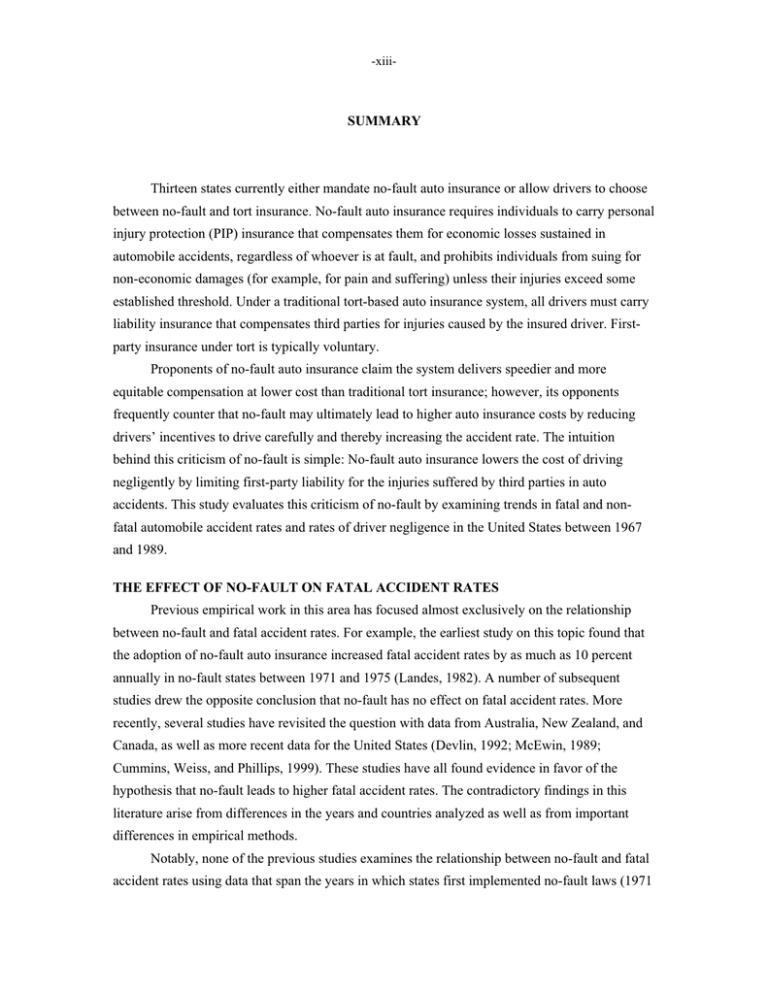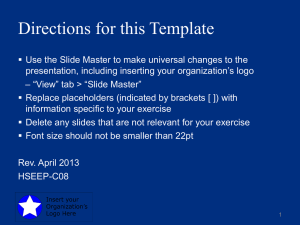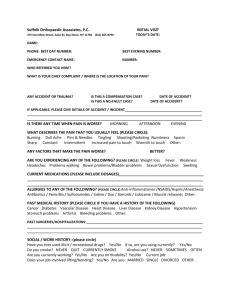SUMMARY Thirteen states currently either mandate no-fault auto insurance or allow... between no-fault and tort insurance. No-fault auto insurance requires individuals...
advertisement

-xiii- SUMMARY Thirteen states currently either mandate no-fault auto insurance or allow drivers to choose between no-fault and tort insurance. No-fault auto insurance requires individuals to carry personal injury protection (PIP) insurance that compensates them for economic losses sustained in automobile accidents, regardless of whoever is at fault, and prohibits individuals from suing for non-economic damages (for example, for pain and suffering) unless their injuries exceed some established threshold. Under a traditional tort-based auto insurance system, all drivers must carry liability insurance that compensates third parties for injuries caused by the insured driver. Firstparty insurance under tort is typically voluntary. Proponents of no-fault auto insurance claim the system delivers speedier and more equitable compensation at lower cost than traditional tort insurance; however, its opponents frequently counter that no-fault may ultimately lead to higher auto insurance costs by reducing drivers’ incentives to drive carefully and thereby increasing the accident rate. The intuition behind this criticism of no-fault is simple: No-fault auto insurance lowers the cost of driving negligently by limiting first-party liability for the injuries suffered by third parties in auto accidents. This study evaluates this criticism of no-fault by examining trends in fatal and nonfatal automobile accident rates and rates of driver negligence in the United States between 1967 and 1989. THE EFFECT OF NO-FAULT ON FATAL ACCIDENT RATES Previous empirical work in this area has focused almost exclusively on the relationship between no-fault and fatal accident rates. For example, the earliest study on this topic found that the adoption of no-fault auto insurance increased fatal accident rates by as much as 10 percent annually in no-fault states between 1971 and 1975 (Landes, 1982). A number of subsequent studies drew the opposite conclusion that no-fault has no effect on fatal accident rates. More recently, several studies have revisited the question with data from Australia, New Zealand, and Canada, as well as more recent data for the United States (Devlin, 1992; McEwin, 1989; Cummins, Weiss, and Phillips, 1999). These studies have all found evidence in favor of the hypothesis that no-fault leads to higher fatal accident rates. The contradictory findings in this literature arise from differences in the years and countries analyzed as well as from important differences in empirical methods. Notably, none of the previous studies examines the relationship between no-fault and fatal accident rates using data that span the years in which states first implemented no-fault laws (1971 -xiv- to 1976). This methodological weakness leaves these studies open to the criticism that they failed to control adequately for characteristics correlated with both the adoption of no-fault and the fatal accident rate. That is, states that adopted no-fault auto insurance in the 1970s were not a random subset of all states; they adopted no-fault for a reason, and that reason could be correlated with fatal accident rates in those states. Failing to control for the factors that led some states to adopt a no-fault auto insurance system, and others to retain a tort system, can introduce bias into estimates of the effect of no-fault on fatal accident rates. This present study takes a simple approach to examining the effects of no-fault auto insurance on fatal accident rates by comparing differences in fatal accident rates between tort and no-fault states both before and after the 1971 to 1976 period of no-fault implementation. In both tort and no-fault states, fatal accident rates fell steadily over the study period 1967 to 1989 (see Figure S-1). Fatal accident rates fell particularly sharply between 1967 and 1978, and the fact that they fell sharply in both tort and no-fault states suggests that factors common to both tort and nofault states influenced fatal accident rates over this period. Such factors might include greater seat-belt use, declining rates of drinking and driving, and heightened vehicle and road safety. RANDMR1384-S.1 7 Fatalities per 100 million VMT 6 Tort 5 No-fault 4 3 2 1 0 67 70 73 76 79 82 85 88 91 94 NOTE: No-fault states are those states that passed no-fault by 1976. SOURCE: U.S. Department of Transportation. Figure S-1—Fatal Accident Rates in Tort and No-Fault States: 1967 to 1995 -xv- The key question here is whether fatal accident rates fell relatively more in tort than in nofault states between the years before and after implementation of no-fault laws. If so, it could be argued that implementation of no-fault laws caused fatal accident rates in no-fault states to decline less rapidly than they otherwise would have. Or, in other words, such a finding would indicate that no-fault laws caused fatal accident rates to be higher than they would have been under tort. This study performs just such a “difference-in-differences” analysis by controlling for differences both across and within states over time in the level of urbanicity, climate, and per capita income and, importantly, state-specific pre-implementation time trends in fatal accident rates. Contrary to the set of recent studies, the analysis finds no evidence that the implementation of no-fault laws influenced the fatal accident rate in no-fault states. A different empirical approach using within-state variation in dollar thresholds also rejects the hypothesis that no-fault auto insurance influences fatal accident rates. THE EFFECT OF NO-FAULT ON THE OVERALL ACCIDENT RATE Many things must be true if one were to observe a causal relationship between no-fault insurance and fatal accident rates. First, drivers must believe the expected cost of getting into an accident is lower under no-fault than under tort. Second, a decrease in the expected cost of getting into an accident must cause drivers to drive less carefully than they would otherwise. Third, the degree of this effect must be large enough to cause a statistically significant change in accident rates generally. And fourth, this induced change in accident rates must translate into higher fatal accident rates. Given how far removed fatal accident rates are from the immediate impact of no-fault on driver behavior and the highly idiosyncratic nature of many fatal accidents, it is perhaps not entirely surprising that the data do not reveal an empirical relationship between no-fault and fatal accident rates. Consequently, this study takes a step back and asks whether no-fault affects the overall accident rate and whether it affects driver negligence more generally. Past researchers have avoided examining the overall accident rate because of poor data. Many accidents go unreported to the police and, more significantly, the incentive to report accidents to the police might vary between tort and no-fault states. This study avoids this data problem by employing a proxy measure for the overall accident rate—the ratio of property damage claims to property damage exposure. Whereas this measure no doubt underestimates the overall accident rate, it is measured consistently across tort and no-fault states and over time. Controlling for state characteristics, this report finds that accident rates are no higher in no-fault states than in tort states over the period 1976 to 1998. -xvi- Even though no pre-implementation data on accident rates are available, and therefore a difference-in-differences approach is not feasible, this report argues that any bias introduced into these empirical estimates should be in the direction of finding a positive relationship between nofault and the accident rate. Thus, one can be reasonably confident that the finding here of no effect would hold were one to have access to data on accident rates prior to 1971. In addition, an alternative empirical approach using within-state variation in dollar thresholds also rejects the hypothesis that no-fault auto insurance influences accident rates. THE EFFECT OF NO-FAULT ON DRIVER NEGLIGENCE A final empirical test of the no-fault hypothesis is conducted using data from the Department of Transportation’s (DOT’s) Fatal Accident Reporting System (FARS), a census of all fatal accidents in the United States between 1975 and 1998. Among the elements recorded in the FARS data are indicators for whether some traffic violation or other negligent behavior on the part of any of the drivers precipitated the accident. These elements include speeding, improper lane changing, failure to stop or signal, unsafe passing, and other negligent actions. FARS also reports on the blood alcohol content (BAC) of drivers involved in accidents when available. This study uses this FARS information to test the hypothesis that the incidence of negligence as a contributory factor in fatal accident rates should be higher in no-fault states than in tort states. Controlling for detailed characteristics of the accidents themselves, the study finds little support for the hypothesis that no-fault affects rates of driver negligence in fatal accidents. THE EFFECT OF NO-FAULT ON THE EXPECTED COST OF ACCIDENTS As argued earlier, if no-fault is to lower the level of care drivers exercise, it must be the case that no-fault lowers the expected cost of getting into an accident. Whereas a rigorous empirical test of this hypothesis is not possible with available data, this report argues on a priori grounds that there is little reason to believe that no-fault as implemented in the United States significantly affects expected accident costs. Presumably, the overriding reason to drive carefully is self-preservation, an incentive that does not vary between no-fault and tort states. Moreover, no-fault insurance creates many of the same incentives to drive carefully as tort insurance. First, no evidence exists that insurance companies are any less likely to penalize drivers for accidents they may cause under no-fault insurance. Getting into an accident in a no-fault state is just as likely to increase insurance premiums as getting into an accident in a tort state. Second, property damage is covered under third-party liability in all states but Michigan. Therefore, expected property damage costs should be the same in both tort and no-fault states. -xvii- Previous research frequently cites the limitation no-fault places on liability for noneconomic damages as a major reason why no-fault lowers the incentive to drive carefully. There are several problems with this argument, however. First, no-fault insurance systems in the United States shield only a fraction of claims from non-economic damages (typically less than 75 percent). Furthermore, the expected cost of non-economic damages to the at-fault driver in tort states is quite low (median non-economic damages amounted to roughly $1,600 in 1997) and, in any case, these damages are typically insured. Thus, compared with self-preservation and the desire to avoid traffic citations, the margin over which no-fault might change the incentive to drive with care seems rather small indeed. Given the weakness of the theoretical link between no-fault and expected accident costs, it is somewhat surprising, then, that the question of the incentive effects of no-fault have played such a powerful role in the debate over no-fault in both state legislatures and in the federal arena. Empirical estimates can have a major influence on policy debates, however. If we were to take the findings of Landes (1982), Devlin (1992), and Cummins, Weiss, and Phillips (1999) at face value, no-fault could be construed to have led to as many as 5,600 additional highway fatalities in no-fault states between 1991 and 1995 alone. If this were true, it would be hard to justify the adoption of no-fault insurance. The previous empirical estimates are not credible, however. The results of the present study show convincingly that not only does no statistically significant relationship exist between the adoption of no-fault and fatal accident rates, but no statistically significant relationship exists between no-fault and accident rates overall or other measures of driver care. Also, no-fault auto insurance as implemented in the United States, even in its strictest form, is unlikely to significantly lower the expected cost of an auto accident to the at-fault driver. Therefore, even a priori, it seems implausible that no-fault auto insurance could have a substantive impact on driver behavior. Consequently, while there may be reasons to oppose the concept of no-fault auto insurance, its effect on driver behavior and accidents should not be among them.

